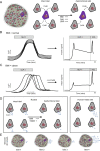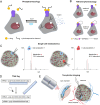The role of beta cell heterogeneity in islet function and insulin release
- PMID: 29661799
- PMCID: PMC5976077
- DOI: 10.1530/JME-18-0011
The role of beta cell heterogeneity in islet function and insulin release
Abstract
It is becoming increasingly apparent that not all insulin-secreting beta cells are equal. Subtle differences exist at the transcriptomic and protein expression levels, with repercussions for beta cell survival/proliferation, calcium signalling and insulin release. Notably, beta cell heterogeneity displays plasticity during development, metabolic stress and type 2 diabetes mellitus (T2DM). Thus, heterogeneity or lack thereof may be an important contributor to beta cell failure during T2DM in both rodents and humans. The present review will discuss the molecular and cellular features of beta cell heterogeneity at both the single-cell and islet level, explore how this influences islet function and insulin release and look into the alterations that may occur during obesity and T2DM.
Keywords: diabetes II; insulin secretion; metabolism; pancreatic beta cell.
© 2018 The authors.
Figures



Similar articles
-
Islet autoimmunity identifies a unique pattern of impaired pancreatic beta-cell function, markedly reduced pancreatic beta cell mass and insulin resistance in clinically diagnosed type 2 diabetes.PLoS One. 2014 Sep 16;9(9):e106537. doi: 10.1371/journal.pone.0106537. eCollection 2014. PLoS One. 2014. PMID: 25226365 Free PMC article.
-
Beta-cell function and mass in type 2 diabetes.Dan Med Bull. 2009 Aug;56(3):153-64. Dan Med Bull. 2009. PMID: 19728971
-
Cellular Senescence in Diabetes Mellitus: Distinct Senotherapeutic Strategies for Adipose Tissue and Pancreatic β Cells.Front Endocrinol (Lausanne). 2022 Mar 31;13:869414. doi: 10.3389/fendo.2022.869414. eCollection 2022. Front Endocrinol (Lausanne). 2022. PMID: 35432205 Free PMC article. Review.
-
EP4 signalling is essential for controlling islet inflammation by causing a shift in macrophage polarization in obesity/type 2 diabetes.Diab Vasc Dis Res. 2020 Jul-Aug;17(4):1479164120945675. doi: 10.1177/1479164120945675. Diab Vasc Dis Res. 2020. PMID: 32722929 Free PMC article.
-
Interorgan crosstalk in pancreatic islet function and pathology.FEBS Lett. 2022 Mar;596(5):607-619. doi: 10.1002/1873-3468.14282. Epub 2022 Jan 19. FEBS Lett. 2022. PMID: 35014695 Free PMC article. Review.
Cited by
-
The Eye as a Transplantation Site to Monitor Pancreatic Islet Cell Plasticity.Front Endocrinol (Lausanne). 2021 Apr 23;12:652853. doi: 10.3389/fendo.2021.652853. eCollection 2021. Front Endocrinol (Lausanne). 2021. PMID: 33967961 Free PMC article. Review.
-
Acid-Resistant BODIPY Amino Acids for Peptide-Based Fluorescence Imaging of GPR54 Receptors in Pancreatic Islets.Angew Chem Int Ed Engl. 2023 May 8;62(20):e202302688. doi: 10.1002/anie.202302688. Epub 2023 Apr 12. Angew Chem Int Ed Engl. 2023. PMID: 36917014 Free PMC article.
-
Characterization of the Secretome, Transcriptome, and Proteome of Human β Cell Line EndoC-βH1.Mol Cell Proteomics. 2022 May;21(5):100229. doi: 10.1016/j.mcpro.2022.100229. Epub 2022 Apr 2. Mol Cell Proteomics. 2022. PMID: 35378291 Free PMC article.
-
Paracrine signaling in islet function and survival.J Mol Med (Berl). 2020 Apr;98(4):451-467. doi: 10.1007/s00109-020-01887-x. Epub 2020 Feb 17. J Mol Med (Berl). 2020. PMID: 32067063 Free PMC article. Review.
-
Symbiosis of Electrical and Metabolic Oscillations in Pancreatic β-Cells.Front Physiol. 2021 Dec 3;12:781581. doi: 10.3389/fphys.2021.781581. eCollection 2021. Front Physiol. 2021. PMID: 34925070 Free PMC article. Review.
References
-
- Aichler M, Borgmann D, Krumsiek J, Buck A, MacDonald PE, Fox JEM, Lyon J, Light PE, Keipert S, Jastroch M, et al 2017. N-acyl taurines and acylcarnitines cause an imbalance in insulin synthesis and secretion provoking β cell dysfunction in type 2 diabetes. Cell Metabolism 25 1334.e1334–1347.e1334. (10.1016/j.cmet.2017.04.012) - DOI - PubMed
Publication types
MeSH terms
Substances
Grants and funding
LinkOut - more resources
Full Text Sources
Other Literature Sources
Medical

